The Seagate BarraCuda (500GB) SSD Review: Getting Back In The Game
by Billy Tallis on December 7, 2018 8:00 AM ESTRandom Read Performance
Our first test of random read performance uses very short bursts of operations issued one at a time with no queuing. The drives are given enough idle time between bursts to yield an overall duty cycle of 20%, so thermal throttling is impossible. Each burst consists of a total of 32MB of 4kB random reads, from a 16GB span of the disk. The total data read is 1GB.

The burst random read speed of the Seagate BarraCuda is rather slow, both in comparison to the broad field of competing SSDs, and in comparison to the other drives that use Toshiba's 3D TLC: the Plextor M8V is 30% faster, and even the DRAMless Toshiba TR200 is 15% faster.
Our sustained random read performance is similar to the random read test from our 2015 test suite: queue depths from 1 to 32 are tested, and the average performance and power efficiency across QD1, QD2 and QD4 are reported as the primary scores. Each queue depth is tested for one minute or 32GB of data transferred, whichever is shorter. After each queue depth is tested, the drive is given up to one minute to cool off so that the higher queue depths are unlikely to be affected by accumulated heat build-up. The individual read operations are again 4kB, and cover a 64GB span of the drive.
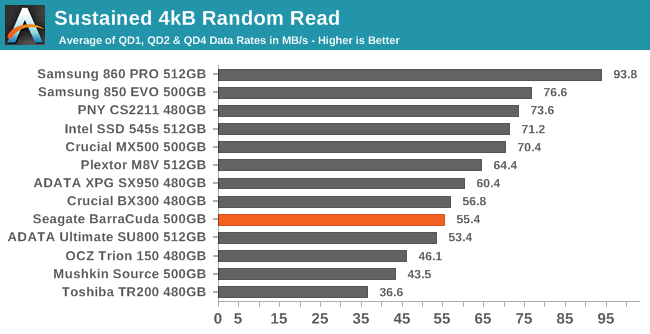
On the longer random read test, the BarraCuda appropriately pulls ahead of the Toshiba TR200 but remains much slower than the other current-generation mainstream competitors.
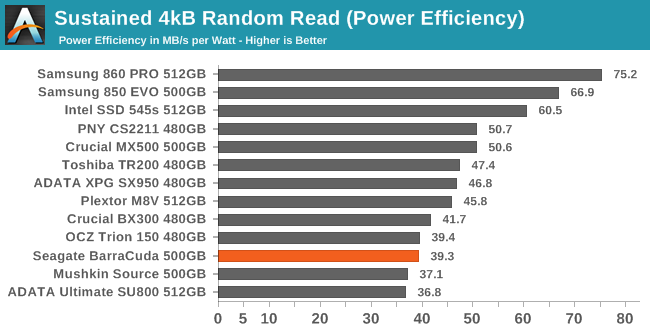 |
|||||||||
| Power Efficiency in MB/s/W | Average Power in W | ||||||||
The BarraCuda is among the most power-hungry drives on this test, leaving it with a very poor power efficiency rating. The best TLC SATA drives offer 50% better performance per Watt, and the Plextor M8V gets 16% better performance while drawing the same amount of power.
 |
|||||||||
As queue depths increase, the BarraCuda stays a little bit slower than most mainstream TLC SSDs, and past QD16 it starts to level out with significantly slower random read performance than the competition. On the bright side, power consumption doesn't increase very quickly as queue depth grows, so the efficiency at high queue depths is no longer such a negative outlier.
Comparing the Seagate BarraCuda against our entire collection of SATA SSDs new and old, it's clear that the power efficiency could use some improvement but it's by no means the worst we've tested.
Random Write Performance
Our test of random write burst performance is structured similarly to the random read burst test, but each burst is only 4MB and the total test length is 128MB. The 4kB random write operations are distributed over a 16GB span of the drive, and the operations are issued one at a time with no queuing.

The Seagate BarraCuda disappoints on the burst random write test with QD1 performance that is well below that of many current and previous generation SSDs, including some DRAMless drives. The Plextor M8V is 36% faster on this test due to pairing the same Toshiba NAND with a more recent Silicon Motion controller rather than the Phison S10.
As with the sustained random read test, our sustained 4kB random write test runs for up to one minute or 32GB per queue depth, covering a 64GB span of the drive and giving the drive up to 1 minute of idle time between queue depths to allow for write caches to be flushed and for the drive to cool down.
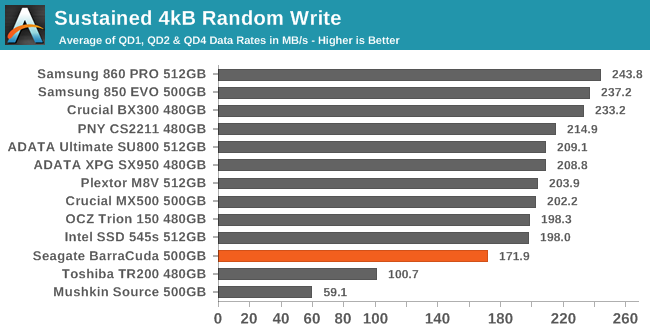
On the longer random write test that involves some higher queue depths, the differences between mainstream SATA drives are smaller than at QD1 but the BarraCuda is still clearly below par. However, it is at least far faster than the DRAMless drives.
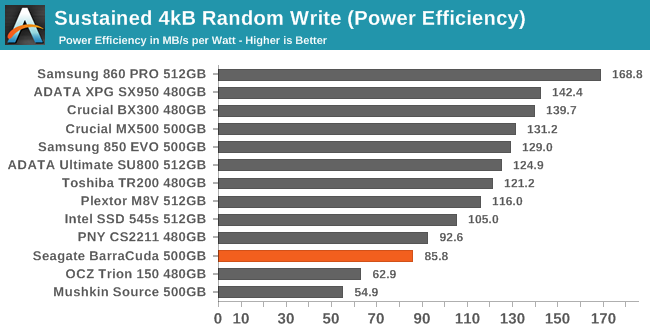 |
|||||||||
| Power Efficiency in MB/s/W | Average Power in W | ||||||||
Power consumption for the BarraCuda on this test is a bit high, so the efficiency score is again fairly low. Other current mainstream SATA SSDs offer at least 20% better performance per Watt. The Plextor M8V is 18% faster while drawing 12% less power, and that still isn't close to the best efficiency we're seeing from non-Toshiba 3D TLC.
 |
|||||||||
Random write performance saturating at QD4 and higher is normal for SATA drives, but the performance level that the BarraCuda tops out at is well below what we expect from mainstream SSDs these days. The Plextor M8V delivers more performance at lower power levels across all queue depths, while using a 4-channel Silicon Motion controller instead of the 8-channel Phison S10 to manage the same Toshiba 3D TLC.
Comparing the Seagate BarraCuda against every SATA SSD that has completed this test, we again see that power consumption is substantially higher than the best drives out there, and the maximum random write performance attained falls far short of the best that a SATA drive can deliver.


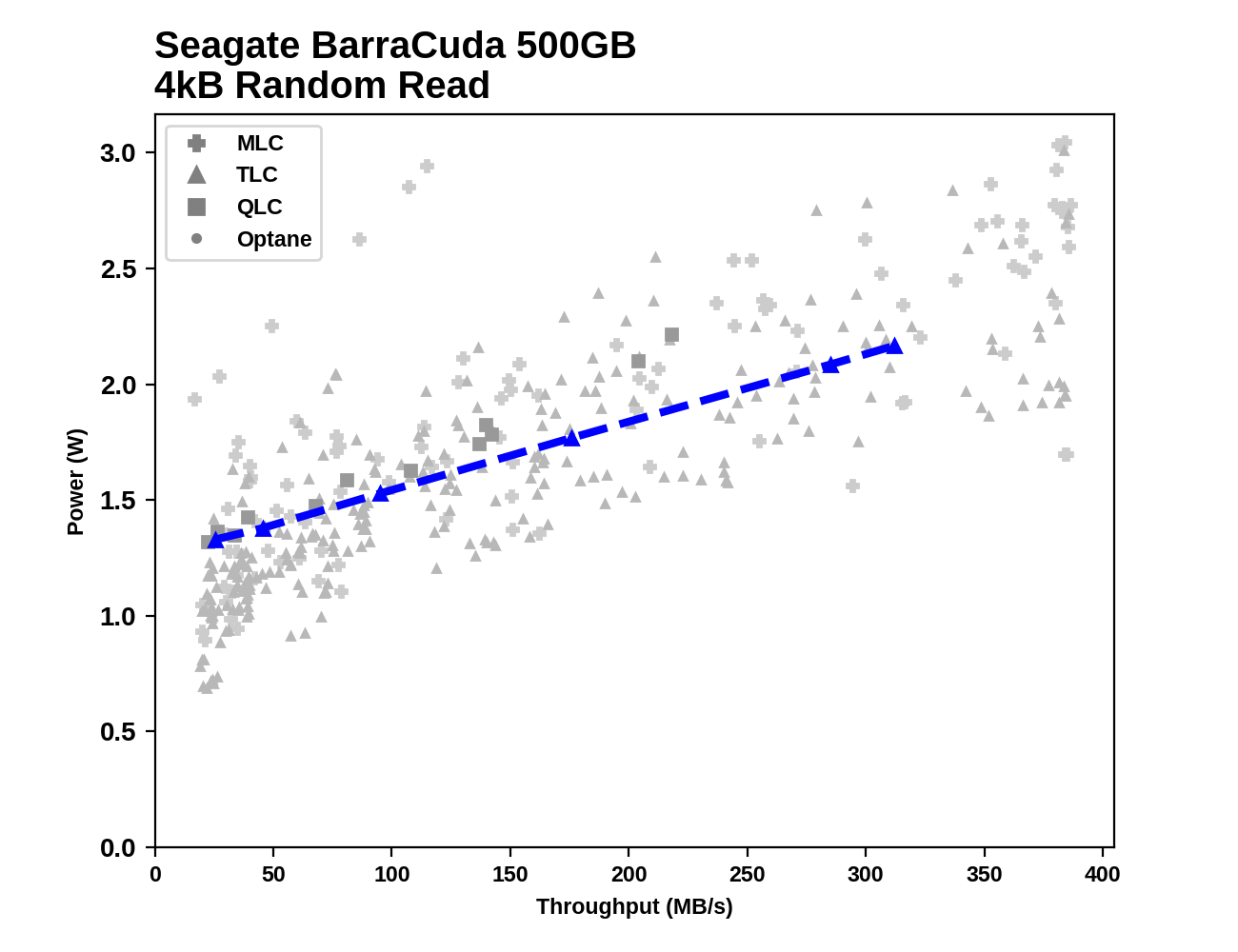
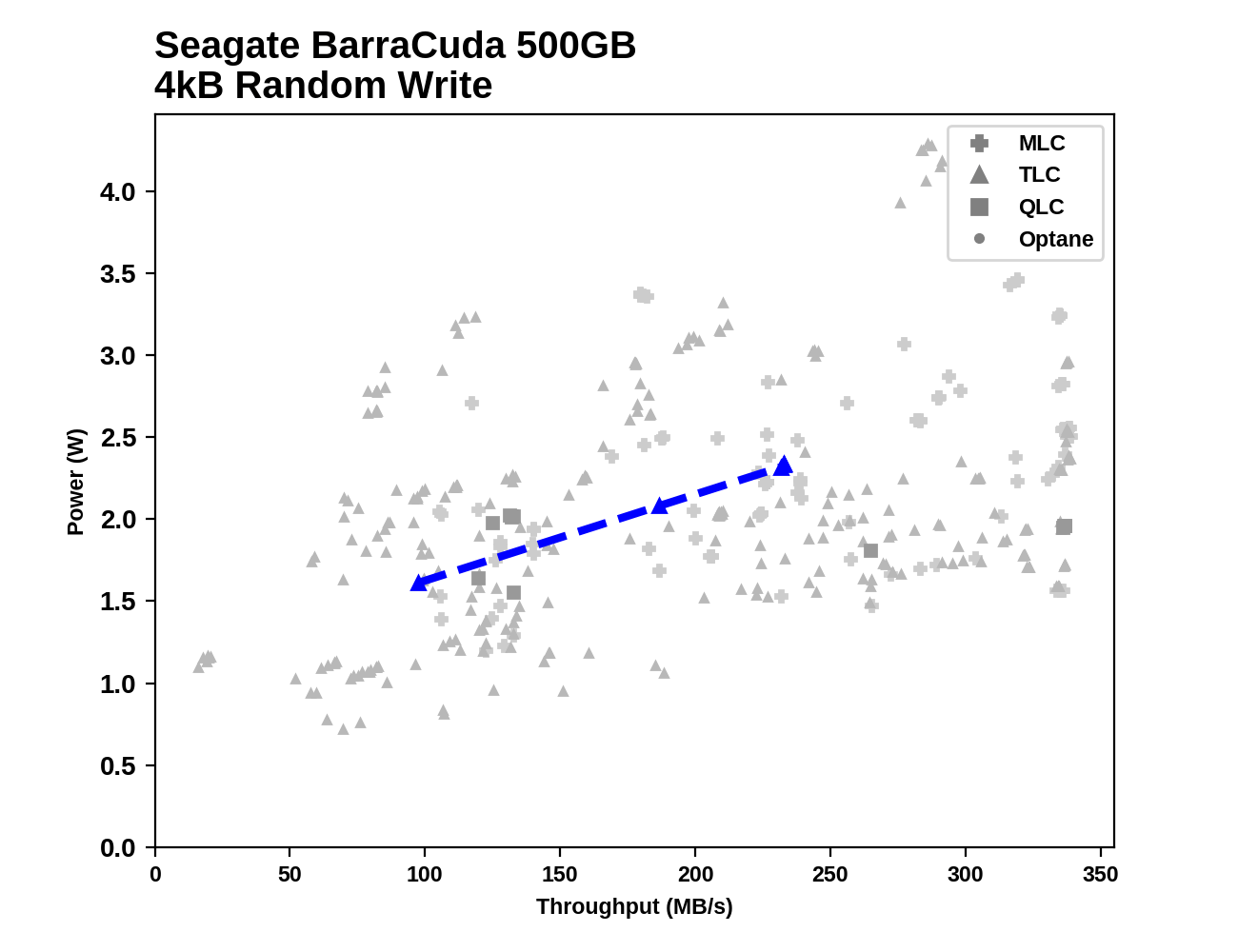








39 Comments
View All Comments
Hulk - Friday, December 7, 2018 - link
Fantastic review as always. Thanks for your hard work.But I'm curious as to why the Samsung EVO 860 isn't in the benchmarks. It was recently selling for under $130 (not back at $150) and seems to be the benchmark to which most drives in this category should be compared?
Gasaraki88 - Friday, December 7, 2018 - link
The 850 EVO and 860 EVO are very similar in performance.Samus - Friday, December 7, 2018 - link
The problem for Samsung's consumer market is they've been making drives that max out the capabilities of SATA for 5 years. There just isn't much more room to improve.And the problem for Samsung's prosumer market is the WD Black NVMe is an overall better value than the 970 NVMe, ESPECIALLY in mobile where the 970's (even the EVO) are so power hungry they constantly throttle in laptops, while reducing battery life.
Samsung is riding on reputation right now. Superior products in the SATA space are irrelevant because at the high end you wont notice a real difference between SATA drives. And in the NVMe space, there are plenty of players on par with Samsung.
zodiacfml - Monday, December 10, 2018 - link
I used to think that SATA is dumb for recent SSDs. However, I noticed that it is only for sequential workloads which can be left running in the background. SATA still has a lot of life for SSDs.The 2.5" form factor is still dumb though. It is huge waste of space and materials.
Can't they make the case the size of the PCB using only the first pair of screws for mounting?
derekullo - Monday, December 10, 2018 - link
The reason this was done was to safe on space knowing that eventually they would deployed in laptops.Another reason was that when ssds were first being released with SLC, they were incredibly expensive and nobody could afford to buy your 1 Terabyte 3.5" drive filled to the brim with SLC nand. Of course we can afford it now ...
derekullo - Monday, December 10, 2018 - link
save on space* be deployed*Billy Tallis - Friday, December 7, 2018 - link
My smallest 860 EVO sample is 1TB, and I didn't want to put that on the graphs as the only drive of that capacity. Performance generally increases with drive capacity, so the 1TB would exaggerate the performance advantage of the 860 EVO over the BarraCuda (and probably slightly understate the efficiency advantage). You can make the comparison with our Bench tool if you're interested: https://www.anandtech.com/bench/product/2201?vs=21...Hulk - Friday, December 7, 2018 - link
Okay that makes sense.Death666Angel - Friday, December 7, 2018 - link
2.5" SATA SSDs should just become M.2 SATA SSDs with a caddy. :)Dragonstongue - Friday, December 7, 2018 - link
not everyone has m.2 on their boards and many of those boards overheat the drive in that slot anyways....t each own, "slow" drives are best kept as full out SATA sized drive (which vast majority are 2.5" anyways. the samsung 8/9xx are "unique" in that the pcb housing the memory chips etc is quite small compared to many so they "easily" put on a m.2 "gum stick"